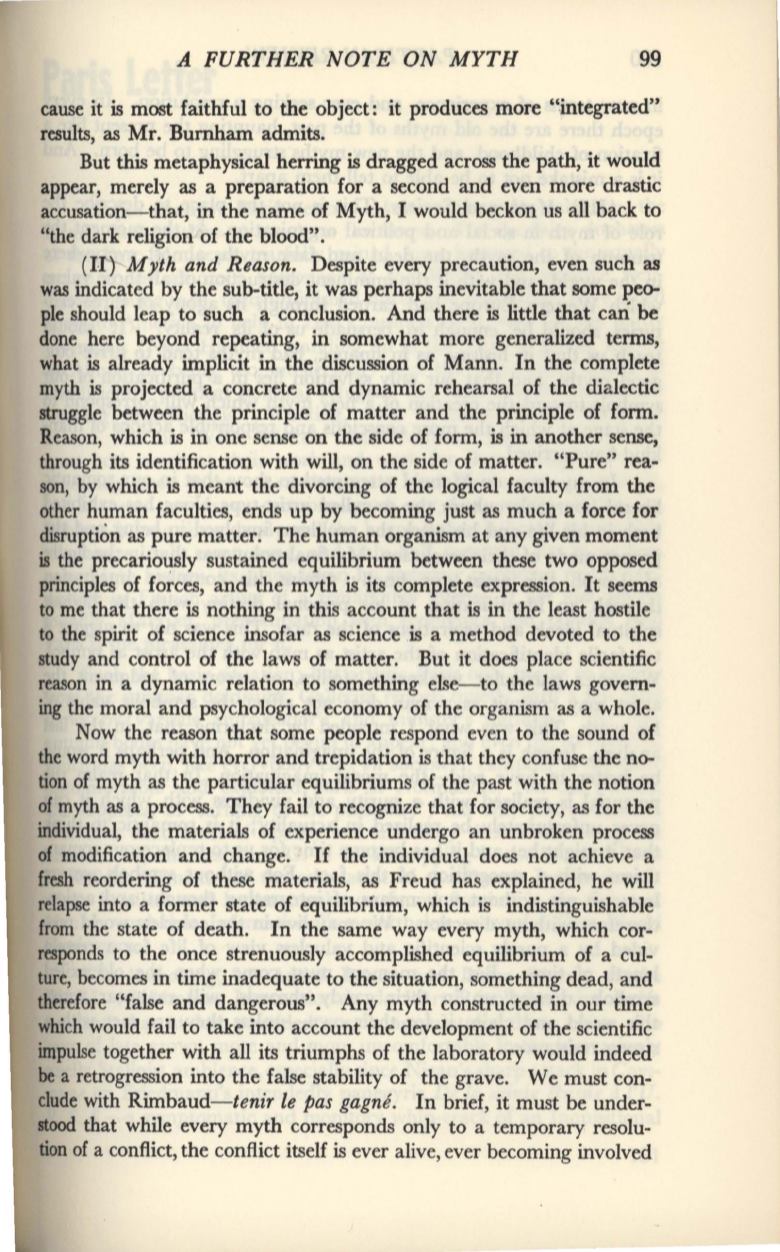
A FURTHER NOTE ON MYTH
99
cause it is most faithful to the object: it produces more "integrated"
results, as Mr. Burnham admits.
But
this
metaphysical herring is dragged across the path, it would
appear, merely as a preparation for a second and even more drastic
accusation-that, in the name of Myth, I would beckon us all back to
"the dark religion of the blood".
(11}--Myth and Reason.
Despite every precaution, even such as
was indicated by the sub-title, it was perhaps inevitable that some peo–
ple should leap to such a conclusion. And there is little that can be
done here beyond repeating, in somewhat more generalized terms,
what is already implicit in the discussion of Mann. In the complete
myth is projected a concrete and dynamic rehearsal of the dialectic
struggle between the principle of matter and the principle of form.
Reason, which is in one sense on the side of form, is in another sense,
through its identification with will, on the side of matter. "Pure" rea–
son, by which is meant the divorcing of the logical faculty from the
other human faculties, ends up by becoming just as much a force for
disruption as pure matter. The human organism at any given moment
is
the precariously sustained equilibrium between these two opposed
principles of
fo~ces,
and the myth is its complete expression. It seems
to me that there is nothing in this account that is in the least hostile
to the spirit of science insofar as science is a method devoted to the
study and control of the laws of matter. But it does place scientific
reason in a dynamic relation to something else-to the laws govern–
ing
the moral and psychological economy of the organism as a whole.
Now the reason that some people respond even to the sound of
the word myth with horror and trepidation is that they confuse the no–
tion of myth as the particular equilibriums of the past with the notion
of myth as a process. They fail to recognize that for society, as for the
individual, the materials of experience undergo an unbroken process
of modification and change.
If
the individual does not achieve a
fresh reordering of these materials, as Freud has explained, he will
relapse into a former state of equilibrium, which is indistinguishable
from the state of death. In the same way every myth, which cor–
responds to the once strenuously accomplished equilibrium of a cul–
ture, becomes in time inadequate to the situation, something dead, and
therefore "false and dangerous". Any myth constructed in our time
which would fail to take into account the development of the scientific
impulse together with all its triumphs of the laboratory would indeed
be
a retrogression into the false stability of the grave. We must con–
clude with
Rimbaud-tenir le pas gagne.
In brief, it must be under–
stood that while every myth corresponds only to a temporary resolu–
tion of a conflict, the conflict itself is ever alive, ever becoming involved


